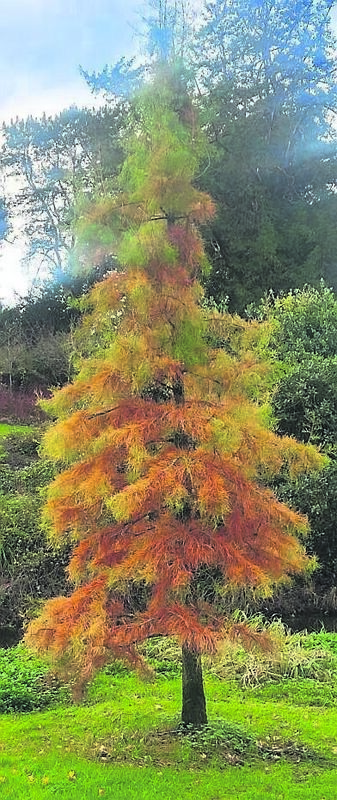How to select the perfect tree to plant in your garden

Zelkova Serrata displaying its autumn hues
THE recent lower temperatures make doing any work outdoors difficult at present, and the low winter sun is slow to warm the short day!
There is, however, a noticeable ‘stretch in the evening’ with maybe an additional 30 minutes of daylight on a good, bright day.
It is all the little things that can give you delight at this time of the year, like the tiny red flowers appearing on the native hazel trees, which are the female flower, as they await pollination by the male flowers bearing pollen in the form of attractive yellow catkins.

The birds become much more active in the garden during frosty weather as they delight in any bird seed, peanuts or fat balls on offer at the feeder.
Do make sure to leave some water out also, as it is important that the birds keep their feathers clean during the winter months to ensure they provide good insulation in cold weather.
While it may not be possible to do a lot in the garden right now, the planning can continue indoors. This is the time of year to retrieve the garden books and leaf through them to get inspired for what to do in our own gardens for 2024.
Now is a great time to consider some tree planting, and choosing the right tree for the right spot is worth researching.
Different trees provide interest at different times of the year - spring flowering, summer flowering, autumn leaf colour, interesting bark, autumn berries and evergreen foliage, compact growing habit, and columnar growing habit are just some of the attributes that we seek for different areas of the garden.
Cherries, for example, flower in spring and provide autumn leaf colour and also many have attractive bark - all of these features make them a very good value plant in the garden, providing interest throughout the year.
There is a huge variety of Acers available and they make an excellent garden tree and range in size from a metre tall to 20 metres. They provide excellent autumn and spring colour with their delicate foliage and some also have attractive bark.
Evergreens provide structure, cover and solidity to the garden, particularly during the winter months. They can also be used to create topiary for added sculptural interest all year round.
Yew is a great tree, which can be planted as a specimen or a hedge and responds well to pruning, so is great for clipping into different shapes.
Salix alba ‘Britzensis’, the scarlet willow, is a vigorous tree with brightly coloured young stems, it does require some management in the form of annual pollarding to keep the stems a vibrant bright colour, so consider this before planting.
There is such a wide variety of trees available now is garden centres, it is worth giving some thought to when you want interest in your garden, how big is the space available, is screening needed, what the soil is like - acid or alkaline - if there is good drainage, if it is a sheltered or exposed spot, and so on,

The following are some larger trees to consider if you have plenty of space in the garden.
Betula utilis ‘Grayswood Ghost’
This is a birch tree that has particularly fine white bark that shines in the winter time when the branches are totally bare. It also produces good autumn colour with golden yellow leaf turn.
It will establish best in full sun on a well-drained soil. It a fast-growing tree that can get to a height of more than 15 metres and a spread of 10 metres.
A beautiful specimen tree, or planted in a grove to give a multi-stemmed effect.
Eucrphia x nymansensis ‘Nymansay’
A a delightful summer flowering medium sized tree with a columnar habit. It will get to about 15 metres tall and about four metres spread and needs a neutral to acid soil.
It will do best in a sheltered site and provide some structure in the garden during winter as it is evergreen.
Robinia pseudoacacia ‘Frisia’, or the False acacia
This is a fragrant summer flowering tree with delicate pinnate deciduous golden foliage.
Noted for its ability to tolerate pollution, it is a popular cityscape tree. It will grow best when given some shelter as the branches can be somewhat brittle.
It will get to about 12 metres high and eight metres wide, growing best in a well-drained soil in full sun.
Taxodium Distichum, or the Swamp Cypress
A deciduous conifer that will do well in a wet soil. It has attractive fresh spring foliage and produces a wonderful display of bright orange needles in the autumn.
It will do best if given some shelter, eventually reaching a height of 20 metres and spread of six metres. A great specimen tree to grow near water.
Zelkova Serrata
These are trees native to Asia which are closely related to elms. They have smooth bark and provide an excellent autumn display of leaf colour. They will grow best on a sheltered site, getting to about 15 metres tall and 10 metres spread.
Taking the time to consider your garden - where you have space to plant a tree, what the growing conditions are, and what effect you want to achieve, will ultimately inform your decision, and this will result in choosing the right plant for your particular space that will do well and provide years of pleasure over the seasons in your garden.
If you would like to dig deeper into selecting the right tree for your garden, then The Essential Tree Selection Guide, written by Henrick Sjöman and Arit Anderson, was recently published and focuses on the environment and ecosystems that trees provide, and the varying roles that different trees play.
Happy Planning and Planting this January.







 App?
App?


